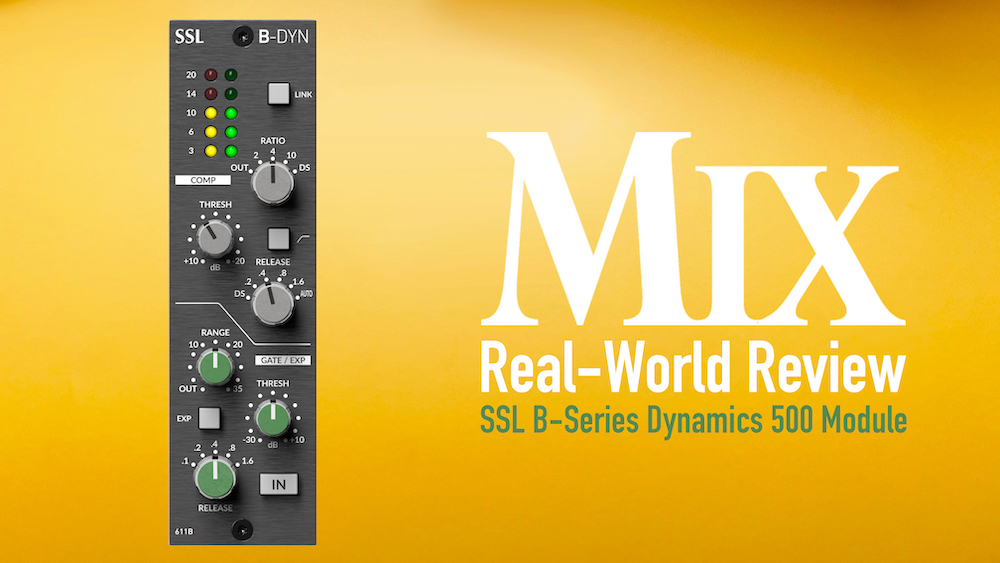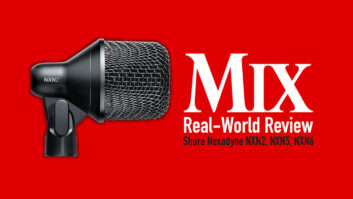
| MIX VERDICT: SOLID STATE LOGIC B-SERIES DYNAMICS 500 MODULE |
| THE TAKEAWAY: “It is fast becoming my “go-to” utility compressor because of its natural sound, with strict control possible if required. It sounds like no other hardware or software dynamics controller out there.” |
| COMPANY: Solid State Logic • www.solidstatelogic.com PRICE: $699 PROS: • The perfect utility compressor with a unique sound. |
The SSL 4000B was the first console ever manufactured by Solid State Logic. While only a handful of the consoles were built, they went to internationally respected facilities like Abbey Road Studios and the Stone Room of Virgin Records’ Townhouse Studio in London; Le Studio in Montreal; and Record Plant in Los Angeles. Plenty of notable tracks, like Phil Collins’ “In the Air Tonight” and Peter Gabriel’s “Intruder” were recorded on SL 4000Bs, but what made it a landmark console was that it was one of the first to offer dynamics processing with its 611B Dynamics module installed at the top of every channel strip.
As deployed, this module offered a certain, unique sonic “personality” and saturated compression style unavailable in 1976, especially in transistorized, standalone, outboard units. At the time, having one on every channel was/is one of many unique attractions of the SSL console (this was all before reliable, “good-sounding,” computer-based DAW systems).
The SSL B-Series Dynamics 500 Module is the single-channel 611B module taken directly from the SSL 4000B console that has been physically resized and electronically modified to fit into a single slot of a 500 Series rack. The only circuit enhancement/update is the addition of a switchable -6 dB/ octave, 165 Hz, high-pass, side-chain filter in the compressor section.
Focusrite Scarlett 2i2 Studio — A Mix Real-World Review
The B-Dyn 500 module matches the sound of the original 611B in listening tests made by Chris Jenkins, the original house engineer at Townhouse Studios. Jenkins, now retired, spent 40 years with SSL, eventually becoming the Director of Commercial Applications.
The B-Dyn module uses a VCA “feedback” design with a peak detector in the sidechain. Now, with the exception of the SSL Bus Compressor, all SSL dynamic modules are “feed forward” designs and use the channel fader’s VCA rather than its own dedicated VCA as the B-Dyn did. The later E Series channel dynamics sections use RMS side-chain detection, not peak, for hard-knee compression.
The B Series are softer knee—a kind of “over-easy” sound because the original B Series Channel Dynamics used a long-obsolete dbx 202 “Black Can” VCA.
This new version uses the closest surface-mount equivalent possible, and SSL has even left the old VCA’s connections on the circuit board etch and will provide the details and surrounding component changes required if someone wanted to “devolve” the sound by installing a vintage dbx 202 Gold or Black Can VCA.
The control voltage going to the VCA is a summation of control voltages generated by the Gate/Expander, the Compressor/Limiter and any adjacent (slots) modules when linked together.
Multichannel linking is possible for an entire rack of eight B-Dyn modules for Dolby Atmos, 5.1 or 7.1 surround sound productions.
FRONT PANEL CONTROLS, METERS
At the top right of the front panel is the Link button. If your 500 Series rack is so equipped, two adjacent modules will link together for stereo operation. I used a Fix Audio Designs Bucket 500 Series rack, and there is a jumper you would insert on the motherboard to interconnect the side-chain signals between adjacent modules. Linking is bidirectional; the module changing gain the most applies that change to the other module(s) to prevent stereo image shifting.
Also at the top are two columns of five LEDs each to indicate: gain reduction on the left-most meter, with red and yellow LEDs showing gain reductions of: 3, 6, 10, 14, and 20 dB, respectively. The right column of green LEDs shows the operation of the Gate and Expander section when enabled.
COMPRESSOR/LIMITER/ DE-ESSER

The B-Dyn’s updated design provides makeup gain automatically with better linearity in setting compression/limiter Threshold, especially when using the smaller-sized control knobs for this 500 version.
The compressor’s rotary switch has ratios of: 2:1, 4:1, 10:1, plus a DS limiter ratio available with an Out position for bypassing the compressor entirely. Release times are fixed-switch positions of: 200, 400, 800 and 1,600 milliseconds. There is also a program-dependent Auto Release position similar to the Stereo Bus Compressor in the SSL console.
The module also includes a super-fast DS Release time position for the De-Esser function that varies between 30 and 50 ms. The De-Esser Release time position is separate from the Ratio control’s DS position, so you may have a very fast release set on the Release control and then use a low compression ratio at the same time.
Attack time is always fixed at about 30 ms, but if you use the DS Ratio position, the attack time goes down to a fast 2 ms—faster than an E Series 611E Dynamics module set to Fast. Finally, there is an HPF on/off switch that I mostly kept on (except for kicks and bass) because it has a gentle, -6 dB/octave, 185 Hz high-pass curve.
The B-Dyn module is set to be strictly a De-Esser by switching both the Ratio and Release rotary switches to DS. Now a De-Esser with a 10:1 ratio, it uses a boost at 7 kHz in the sidechain.
I found the De-Esser very effective and smooth—my simple rock n’ roll test is to crank the de-essing up so much that a singer’s “s” starts to sound like a lisp, or it just completely disappears. Then I would increase the threshold setting (less sensitive) until the vocal sounded more natural. Excellent.
GATE/EXPANDER
The Gate/Expander section can work as a 20:1 gate or a 2:1 expander with the EXP button pushed. Range sets how “deep” the Gate shuts down—ranging from bypass and up to 35 dB deep. The stack of green LEDs offers a good visual representation of the action for either gating or expansion.
If you set the Compressor/Limiter’s Threshold to +10 dB and/or the Ratio to the Out position, the Gate/Expander can be used independently. Threshold on the Gate/ Expander section ranges between -30 dB and +10 dB, and becomes active only when the In button is selected. The Attack time of the Gate/ Expander is internally fixed at 0.2 ms, while Release times are fixed rotary-switch positions of: 100, 200, 400, 800 and 1,600 ms. I found both the Gate and Expander very useful for quickly controlling noisy sources—guitar amp noise, or even unwanted room ambiences—in the most natural-sounding way.
IN THE STUDIO
First up was a mastering session for a few publishing song demos with loud vocals and basic backing tracks. I’m not a mastering engineer, but making improvements and other changes on the overall sound of these rough mixes using two linked SSL B-Dyn compressors was easy, fast and effective.
I first applied a corrective EQ using FabFilter’s Pro-Q3 inserted before the SSL modules. The EQ lessened the amount of booming lower-midrange, and I also added a small (depending on the mix and song) 10 kHz shelf boost that seemed to open these mixes up.
Sonnox ListenHub set to Normal on the stereo bus showed about a -10 LUFS at the loudest moments, and I did experiment linking and unlinking the L/R channels to keep the loud lead vocal panned to the center at all times.
Maximum gain reduction was not more than one yellow LED (3 dB) maximum using a ratio of 4. I also found the 185 HPF was excellent, keeping these bass-heavy mixes from pumping too much. For this medium-tempo ballad, release time was best using the Auto position.
In this application, these two B-Series Dynamics 500 Modules sounded like the old SSL stereo bus compressor—feedback with peak sensing, and designed for controlling the main channel signal path. One big sonic difference that separates the B-Dyn is that peak detection improves the reaction time of the feedback design. This is very hearable: only an occasional single gain reduction LED lit up, yet the overall sound was much fuller and richer without sounding too squashed.
Back when analog multitrack recordings without noise reduction systems were the norm, the Gate/Expanders in large-frame SSL consoles were handy for keeping the noise floor generated by either guitar amps and/or analog tape hiss much lower. 24 to 100 channel strips with flashing green LEDs showing gates opening and closing red/yellow gain reduction LEDs became the “hallmark look” of the SSL console.
For me, the SSL B-Series Dynamics 500 Module rekindles that look, along with solid, reliable operation. It is fast becoming my “go-to” utility compressor because of its natural sound, with strict control possible if required. It sounds like no other hardware or software dynamics controller out there. Give it a listen.







